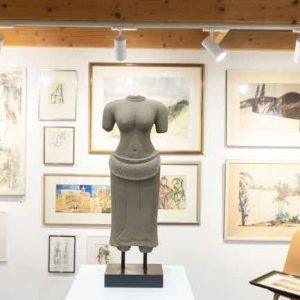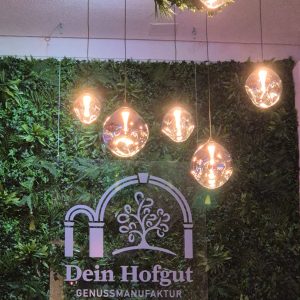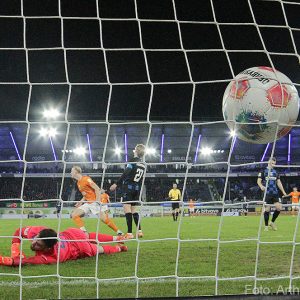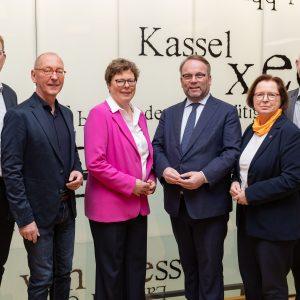ADVERTISING
A contribution by Louisa Albert for the project "What's going on?!" From students at the H_DA
Sports clubs offer important places of leisure activities for young people in the village. But they have to deal with challenges such as falling membership figures and demographic change. In conversation with two scientists and a young footballer.
Eleven men, arms around their shoulders and their heads together. A scream, a whistle. It is Sunday afternoon and between the fields and forest the soccer team of the SKG Nieder-Beerbach meets FTG Pfungstadt II. On the edge of the field, the audience dries the first sweat beads from the forehead, while an attack on the goal is already being dared to go on the place. Next to it. There is still applause. Every week it is time to move to the football game, says Jannis Feuser. The 22-year-old has been playing as a full-back at the SKG for several years. He grew up here, in Nieder-Beerbach. With around 1800 inhabitants: the place belongs to the municipality of Mühltal. It takes a good 20 minutes to Darmstadt - by car, of course. "Nobody comes by public transport, I can assure that," says Janis and laughs.

He now lives in Darmstadt. It is not a matter of course that he still goes to his home village every week for training and games. Many clubs in rural regions suffer from the demographic change that runs through society. Better infrastructures, studies or training lure the young people to the cities. What remains are gaps; Not only on the rural job market, but also in cultural and sports clubs.
What remains when everyone goes?
This is a problem for the children and young people who descendants. The sports clubs in particular often represent the only leisure facility alongside everyday school life. They offer places of movement and competition, make community tangible and thus also contribute to rooting in the hometown. "If these social structures become thinner in the rural regions, for example because the settlements are only inhabited by commuters or the community shrinks, then identification can no longer be lived and a kind of uprooting follows," says Lutz Thieme in the interview. The sports scientist works as a professor at the Koblenz University of Applied Sciences and has been researching sports clubs for many years.
In order to keep them alive, young people who stay in their villages or come back after their training are needed, among other things. "Then there are still a major role on site," emphasizes Thieme. Even if friend: still live in the home village inside, the probability is greater that young people will withdraw from the cities. Therefore, the sports club in the village is much more important than the 20th sports club in a small town or the 100th sports club in a larger city. "Precisely because it is the last of their kind. It's like a red list of endangered species. Biodiversity could also be said - social diversity."


The social network in his home village also plays a major role for Janis.
"I chose the club at the time because my friends played there from the past." At that time, one trainer came to him and other young people from the village. The association had a lack of young talent. Janis and almost everyone else agreed to switch to the home club. "Most still play there. These are people who have previously played four leagues. They have relegated for the club, so to speak," says Janis, adding proudly: "We made the promotion last year." This cohesion is what Janis thinks with his club. "I could make it easier and say I go to the gym now and don't have to stick to training times. But this feeling of being part of a team and being used is cool."
Sports clubs have to go over time
Belonging - is that the magical ingredient for the success of the clubs? Voluntary engagement is always intrinsically motivated, explains Lutz Thieme. "People make volunteering because they see fulfillment and meaning. This is not much different for young people than with older ones." However, there is one difference: "The willingness of young people to bind to offices in the long term has decreased. Sports clubs have to be careful that they make appropriate offers to young people to be able to get involved outside of optional offices."
The Swiss sports sociologist Siegfried Nagel also insists on the need to open up to new approaches. Especially when it comes to gaining new members for clubs. "Central to an openness, a welcome culture," he emphasizes in the interview. Janis can also confirm that this is worthwhile, because: “If you do not grew up with club sport, it can quickly feel alien. Then finding yourself into a team is super difficult, especially if you don't know anyone.”

In order to facilitate this entry, the time before and after training can also be used, said Nagel. "A welcome culture is possible and given if there are other activities in the club beyond the 90 -minute sports unit. Social meetings where you can exchange ideas, combined with good drinks and delicious food." In general, it is important to detach yourself from stuck ideas and not always demand a complete adaptation, emphasizes the sports sociologist. At the same time, the existing structures in the clubs could also be used positively. They could promote routines and structure in everyday life and also support them in learning language. "People who have not grew up in the country confirm that the sports club in particular also offers a chance to acquire everyday language through the regular social contacts," says Nagel. "This is how one can give and take."
The collective comes first
Sports clubs offer and take social borders through the composition of the teams. "The youngest with us are 18, the oldest is 51 years old," says Janis. "In addition, you have people in the team who studied, others are still in training. So you have a lot of different characters. Otherwise there is rarely in everyday life." Of course, club life is not always free of disagreements or group formation, but they would be secondary in the game itself. "On the pitch you play the passport to the one who is closest and is best positioned. It doesn't matter whether this is your best friend or someone with whom you may not get along so well." Janis says that this community thinking has shaped him strongly. "You write works and tests at school. It's about how well you perform. In the team it is different, it is always about the collective."

Getting this collective is the challenge of today. Politics can also intervene and support here, for example with targeted support measures. But how much does this support bring from above? "In order for political funding measures to be effective, they must be able to connect," says sports sociologist Nagel and names the promotion of integration as an example. "Especially in rural regions, I observe that sports clubs are primarily facilities in which people are together to regularly exercise. As a realization from this, Nagel concludes that it is important to put yourself in the logic of the clubs. "Such programs should be developed together with the clubs. Or just designed so openly that a club can also define them a bit for itself and does not have to fight with tons of administrative hurdles and specifications."
Trust in the future
In the end, both parties can benefit in the best case. Because, just as the sports clubs depend on political funding, politics needs these learning places for participation and commitment. And even if an often negative image of club culture is drawn through keywords such as “Corona” or “club death” - these places certainly have a future, sports scientist Lutz Thieme is convinced. "I have great confidence in the sports clubs, also in the rural regions. Sports clubs have already survived world wars and dictatorships and always adapted social changes. They are good to motivate people, to bring in energy, time and strength and to reinvent the association again and again."


Janis Association is a good example of this. Contrary to the image of the individualistic generation, he and his teammates have changed from other clubs to Nieder-Beerbach to preserve the SKG, if you ask Janis to inspire young people for club sports, his answer is clear: “I think people have to come to training and look at it. Experience, then you are right here. "
This article was made as part of the project "What's going on" - a teaching editorial team of students from the online journalism course at the Darmstadt University of Applied Sciences (H_DA). Da.news supports the project and publishes selected articles on its platform. Further information and texts are available here and on: www.was-da-los.de













